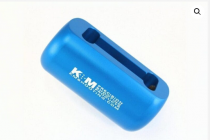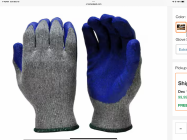I've noticed that after using my case neck turner for awhile that it becomes warm and sometimes warmer, and may as it becomes warmer, the completed case neck thickness may drift one or a few tens of a thousandth away from my set target neck thickness. I wonder if keeping the neck turning device on some sort of cool/cold plate, say maybe a 1" or so thick small aluminum block to serve as a heat sink (in addition to the heat sink built in to the neck turning tool), to keep the turning tool body cool enough and thereby prevent drifts in neck thickness. My understanding is some guys use ice in some fashion to keep the turning tool cool but have given up on this approach because it's messy and wet. Are there ways/devices to have a small portable heat sink to put on my reloading table to set the neck turning tool on between turning cases, that keep the neck turning tool cool to prevent drifting? All comments are welcome.
Install the app
How to install the app on iOS
Follow along with the video below to see how to install our site as a web app on your home screen.
Note: This feature may not be available in some browsers.
You are using an out of date browser. It may not display this or other websites correctly.
You should upgrade or use an alternative browser.
You should upgrade or use an alternative browser.
How to create a heat sink to keep neck turning tools cool and precise
- Thread starter Cassidy
- Start date
I put plenty of oil on the mandrel when I turn and never felt the mandrel getting tight or warm???I've noticed that after using my case neck turner for awhile that it becomes warm and sometimes warmer, and may as it becomes warmer, the completed case neck thickness may drift one or a few tens of a thousandth away from my set target neck thickness. I wonder if keeping the neck turning device on some sort of cool/cold plate, say maybe a 1" or so thick small aluminum block to serve as a heat sink (in addition to the heat sink built in to the neck turning tool), to keep the turning tool body cool enough and thereby prevent drifts in neck thickness. My understanding is some guys use ice in some fashion to keep the turning tool cool but have given up on this approach because it's messy and wet. Are there ways/devices to have a small portable heat sink to put on my reloading table to set the neck turning tool on between turning cases, that keep the neck turning tool cool to prevent drifting? All comments are welcome.
A steel pin .243" in diameter increases 0.00006318" inches in diameter for a 20F temp increase.
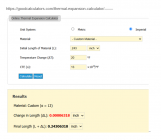
I have a 6"x6" frozen gel pack that I lay my turner on while I unload and load a case onto the case holder. I only need to do this in the summers here in Arizona since my workbench is in my garage where it's triple digit °F. That's been more than enough time to keep the tool at a relatively constant temperature for consistent results.I've noticed that after using my case neck turner for awhile that it becomes warm and sometimes warmer, and may as it becomes warmer, the completed case neck thickness may drift one or a few tens of a thousandth away from my set target neck thickness. I wonder if keeping the neck turning device on some sort of cool/cold plate, say maybe a 1" or so thick small aluminum block to serve as a heat sink (in addition to the heat sink built in to the neck turning tool), to keep the turning tool body cool enough and thereby prevent drifts in neck thickness. My understanding is some guys use ice in some fashion to keep the turning tool cool but have given up on this approach because it's messy and wet. Are there ways/devices to have a small portable heat sink to put on my reloading table to set the neck turning tool on between turning cases, that keep the neck turning tool cool to prevent drifting? All comments are welcome.
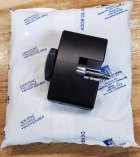
I have a pumpkin turner...the mandrel extends beyond the turner just enough that it makes first contact.
I use an aluminum plate room temp for small batches and let it rest on the plate while i get the next case ready; it cools the mandrel close to the same temp as the plate. if i am doing larger batches i will put the aluminum plate in the freezer the night before.
cheers
I use an aluminum plate room temp for small batches and let it rest on the plate while i get the next case ready; it cools the mandrel close to the same temp as the plate. if i am doing larger batches i will put the aluminum plate in the freezer the night before.
cheers
Me neither .. maybe we’re doing something wrong.I put plenty of oil on the mandrel when I turn and never felt the mandrel getting tight or warm???
bozo699
Gold $$ Contributor
Same as Webster JFrank and ridgeway , with proper mandrel fit, good lube and using the right speed I do usually 100 at a time sometimes only 50 and as high as 300 and I’ve never had a over heating issue using a multitude of different turners, PMA, 21st century, Pumkin, Sinclair and K&M
Wayne
Wayne
6BRA
Gold $$ Contributor
I would agree..a drop of bar and chain prior to each turn on a carbide mandrel.No issues within .0002 all the time. If you have serious donuts, it may heat up.Same as Webster JFrank and ridgeway , with proper mandrel fit, good lube and using the right speed I do usually 100 at a time sometimes only 50 and as high as 300 and I’ve never had a over heating issue using a multitude of different turners, PMA, 21st century, Pumkin, Sinclair and K&M
Wayne
wvlongshot
Gold $$ Contributor
I have one of the small USB powered fans and set it in front of it between cases. Everything stays dry.
I really like turning my case necks so that the variation is very tight, but having said that, when you consider what Bart has done without turning necks, in competition, and the variation in neck thickness of the best brass, it is clear to me that I am fussing just to be fussing, obsessing because I have the tools to measure by very small increments.
I wonder if heat of evaporation from wiping or spraying some acetone or some other safe and olfactory acceptable solvent on the neck turning device every so many cases, or wiping/spraying it on a metal heat sink upon which the turning device is placed between cases, would lower the device temp between neck turns. Haven't tried it, but it came to mind. What do you think?
At one time Joel Pendergraft made an aluminum holder for the K&M neck turner that did an excellent job of controlling temperature and made it easy to use. It was an aluminum disk probably 4 inches in diameter and maybe 2" thick which was knurled around the outside. It had a slot machined in the center where the cutting tool fits and a set screw to hold one side of the cutter against the side of the slot. It worked better than anything I tried until I moved on to turning necks in a lathe.
I don't know if Joel still makes these or not. I see a post from him on here occasionally so he's still around.
Found an article on here about it:
 bulletin.accurateshooter.com
bulletin.accurateshooter.com
I don't know if Joel still makes these or not. I see a post from him on here occasionally so he's still around.
Found an article on here about it:
Gear Review: Pendergraft Holder for K&M Neck Turner « Daily Bulletin
by GS Arizona, Riflemans Journal Neck turning isn't a once-in-a-while operation at my reloading bench. I shoot a lot, go through a fair amount of brass and neck-turn every piece of brass I use.
Last edited:
AlNyhus
Silver $$ Contributor
With my older Sinclair tools (steel mandrels), a plastic bowl full of rubbing alcohol worked well. The turner was set in that while the case was taken off the driver. The brass chips were easily brushed off when it was in the alcohol and the temp stayed consistent. I never felt it was 'messy'...whatever messy is. 
Changing to carbide mandrels made using the alcohol unnecessary.
Changing to carbide mandrels made using the alcohol unnecessary.
xr650rRider
Silver $$ Contributor
Mikemontminy
Silver $$ Contributor
I have a couple pieces of scrap aluminum plate that I will rotate into the freezer which is next to my reloading area. keep One of the cold plates on the bench to put the neck turner down on between cases. Also use a rubber work glove to hold the tool. Makes it easy to hold on to and the heat from my hand won’t warm the tool up. Also gives a good grip on the chuck of the K&M case holder.
Attachments
P1ZombieKiller
Silver $$ Contributor
I use an old aluminum ammo tray i no longer take to the range. I place ice cubes in there and place the cutter on there as needed.
I run 7 different cutters. Some take a turn in the ice ammo tray every turn (once at temp) since they heat up more. Other cutters only take once every other cut. I measure every cut I place and when the thickness starts to vary up a half a click, I know its time to ride the ice.
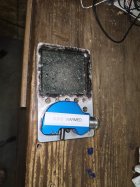
I run 7 different cutters. Some take a turn in the ice ammo tray every turn (once at temp) since they heat up more. Other cutters only take once every other cut. I measure every cut I place and when the thickness starts to vary up a half a click, I know its time to ride the ice.

What are the guys using for lube when the mandrel is getting warm? I have always used petroleum oil and never had the mandrel get warm. Pet oil has about the best oil film strength of any lube. If the mandrel gets warm you are probably using some weird lube instead of petruleum oil.I use an old aluminum ammo tray i no longer take to the range. I place ice cubes in there and place the cutter on there as needed.
I run 7 different cutters. Some take a turn in the ice ammo tray every turn (once at temp) since they heat up more. Other cutters only take once every other cut. I measure every cut I place and when the thickness starts to vary up a half a click, I know its time to ride the ice.
View attachment 1614398
Film strength is a lubricant's ability to resist pressure and maintain a protective layer between moving parts without rupturing. It's a key factor in a lubricant's effectiveness at preventing metal-to-metal contact and reducing wear. Try it.
Last edited:
Similar threads
Upgrades & Donations
This Forum's expenses are primarily paid by member contributions. You can upgrade your Forum membership in seconds. Gold and Silver members get unlimited FREE classifieds for one year. Gold members can upload custom avatars.

Click Upgrade Membership Button ABOVE to get Gold or Silver Status.
You can also donate any amount, large or small, with the button below. Include your Forum Name in the PayPal Notes field.
To DONATE by CHECK, or make a recurring donation, CLICK HERE to learn how.

Click Upgrade Membership Button ABOVE to get Gold or Silver Status.
You can also donate any amount, large or small, with the button below. Include your Forum Name in the PayPal Notes field.
To DONATE by CHECK, or make a recurring donation, CLICK HERE to learn how.










